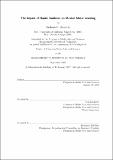| dc.contributor.advisor | Tod Machover. | en_US |
| dc.contributor.author | Grindlay, Graham Charles | en_US |
| dc.contributor.other | Massachusetts Institute of Technology. Dept. of Architecture. Program in Media Arts and Sciences. | en_US |
| dc.date.accessioned | 2008-05-19T15:01:35Z | |
| dc.date.available | 2008-05-19T15:01:35Z | |
| dc.date.copyright | 2007 | en_US |
| dc.date.issued | 2007 | en_US |
| dc.identifier.uri | http://hdl.handle.net/1721.1/41562 | |
| dc.description | Thesis (S.M.)--Massachusetts Institute of Technology, School of Architecture and Planning, Program in Media Arts and Sciences, 2007. | en_US |
| dc.description | This electronic version was submitted by the student author. The certified thesis is available in the Institute Archives and Special Collections. | en_US |
| dc.description | Includes bibliographical references (p. 75-80). | en_US |
| dc.description.abstract | Skilled musical performance provides one of the best demonstrations of the upper limits of the human motor system's capabilities. It is therefore not surprising that learning to play an instrument is a long and difficult process. Teachers and education researchers alike have long since recognized that while learning rate is dependent on the quantity of practice, perhaps even more important is the quality of that practice. However, for non-trivial skills such as music performance, just gaining an understanding of what physical movements are required can be challenging since they are often difficult to describe verbally. Music teachers often communicate complex gesture by physically guiding their students' hands through the required motions. However, at best, this gives a rough approximation of the target movement and begs the question of whether technology might be leveraged to provide a more accurate form of physical guidance. The success of such a system could lead to significant advancements in music pedagogy by speeding and easing the learning process and providing a more effective means of home instruction. This thesis proposes a "learning-by-feel" approach to percussion instruction and presents two different systems to test the effect of guidance on motor learning. The first system, called the FielDrum, uses a combination of permanent and electromagnets to guide a player's drumstick tip through the motions involved in the performance of arbitrary rhythmic patterns. The second system, called the Haptic Guidance System, uses a servo motor and optical encoder pairing to provide precise measurement and playback of motions approximating those involved in snaredrum performance. This device was used in a pilot study of the effects of physical guidance on percussion learning. | en_US |
| dc.description.abstract | (cont.) Results indicate that physical guidance can significantly benefit recall of both note timing and velocity. When subject performance was compared in terms of note velocity recall, the addition of haptic guidance to audio-based training produced a 17% reduction in final error when compared to audio training alone. When performance was evaluated in terms of timing recall, the combination of audio and haptic guidance led to an 18% reduction in early-stage error. | en_US |
| dc.description.statementofresponsibility | by Graham C. Grindlay. | en_US |
| dc.format.extent | 80 p. | en_US |
| dc.language.iso | eng | en_US |
| dc.publisher | Massachusetts Institute of Technology | en_US |
| dc.rights | M.I.T. theses are protected by
copyright. They may be viewed from this source for any purpose, but
reproduction or distribution in any format is prohibited without written
permission. See provided URL for inquiries about permission. | en_US |
| dc.rights.uri | http://dspace.mit.edu/handle/1721.1/7582 | en_US |
| dc.subject | Architecture. Program in Media Arts and Sciences. | en_US |
| dc.title | The impact of haptic guidance on musical motor learning | en_US |
| dc.type | Thesis | en_US |
| dc.description.degree | S.M. | en_US |
| dc.contributor.department | Program in Media Arts and Sciences (Massachusetts Institute of Technology) | |
| dc.identifier.oclc | 225619532 | en_US |
